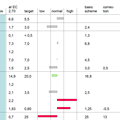The importance of compost analysis for commercial growers using peat-free media
Find out why a grower would perform compost analysis testing and the benefits of doing so when transitioning to peat-free.
Unveil nutrient profiles:
Peat-free growing media can vary in nutrient content based on their source materials. Compost analysis helps growers pinpoint exact nutrient levels, ensuring they can provide plants with a balanced and tailored feeding regime.
Ensure consistency:
Peat has a relatively consistent structure and composition. In contrast, peat-free alternatives can be more variable. Analysing compost allows growers to maintain a consistent growing environment, essential for standardised crop production.
Determine pH Levels:
Peat-free composts can have a wide range of pH levels, depending on their ingredients. Knowing the pH is essential for ensuring nutrient availability and determining whether adjustments are necessary for optimal plant growth.
Monitor microbial activity:
Beneficial microbes play a vital role in plant health and nutrient uptake. Compost analysis can reveal the microbial populations present, allowing growers to foster a healthy soil ecosystem.
Identify potential contaminants:
Contaminants or harmful substances can sometimes be present in composts. Analysis ensures that the growing medium is free from toxins or pathogens that could harm crops.
Assess moisture and air porosity:
The physical structure of peat-free compost affects water retention and air penetration. Analysing the compost can help growers understand these properties, ensuring the root sone has the right balance of moisture and aeration.
Optimise crop-specific needs:
Different crops have unique growing requirements. By analysing the compost, growers can select or adjust their peat-free media to suit the specific needs of each crop, optimising growth conditions.
Sustainable feedback loop:
Regular compost analysis provides data to continuously refine and improve the composting process. This ensures that as the demand for peat-free media rises, the quality and efficiency of production remain high.
Economic efficiency:
Understanding the exact composition of peat-free composts helps growers avoid unnecessary amendments and treatments. This can lead to cost savings and more efficient use of resources.
As the horticulture sectors shift towards more sustainable practices, the use of peat-free growing media becomes increasingly prominent. Regular compost analysis ensures that growers can harness the full potential of these media, guaranteeing the best possible outcomes for their crops and the environment.
Click here to see a typical example of a compost nutrient analysis. You will see on the test that there is a comprehensive analysis showing the results of the test along with recommendations.

